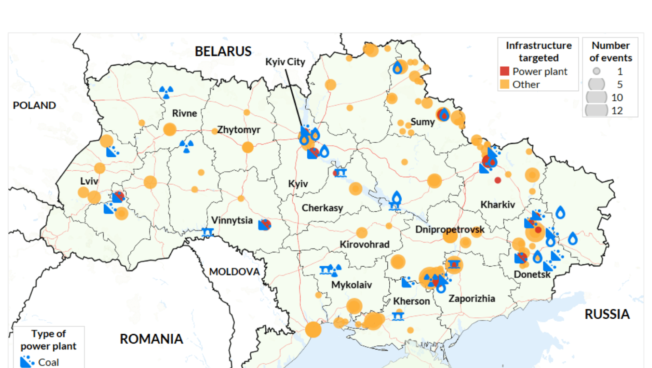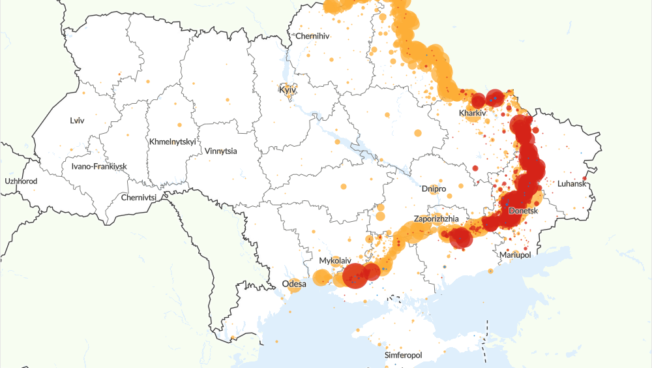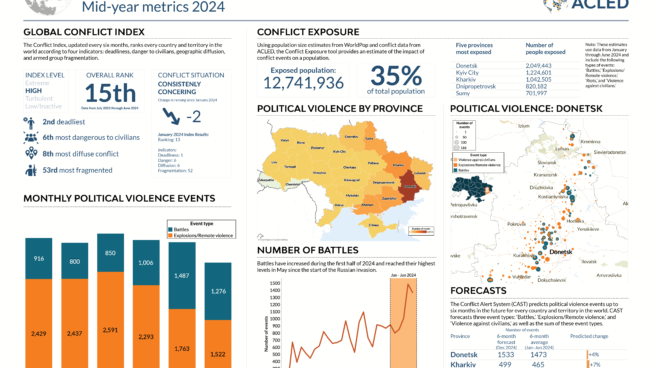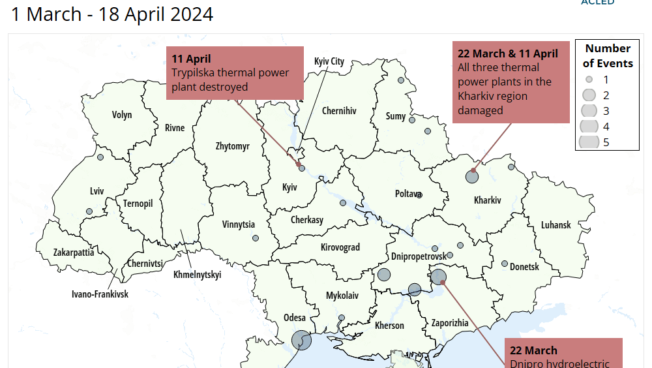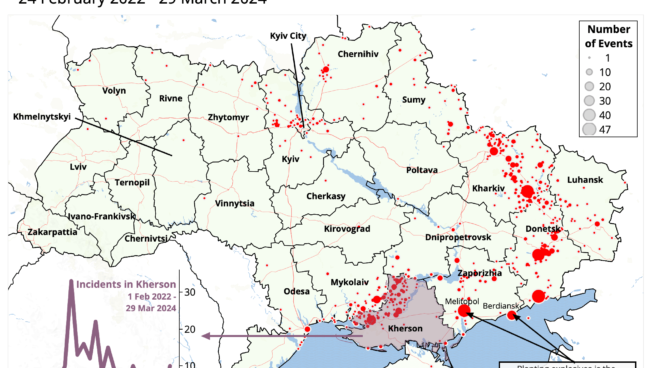Last updated: 2 July 2025
Amid the ongoing war in Ukraine, this aerial photograph shows the destruction in the village of Bohorodychne in the Donetsk region on 27 January 2024. Photo by Roman Pilipey/AFP via Getty Images
ACLED’s Ukraine Conflict Monitor provides near real-time information on the ongoing war, including an interactive map of the latest data from the start of Russia’s invasion, a curated data file, and weekly situation updates. It is designed to help researchers, policymakers, media, and the wider public track key conflict developments in Ukraine. It is released every Wednesday, with data covering events from Saturday to Friday of the preceding week and providing updates to past events as new or better information becomes available.
Ukraine war situation update
21 – 27 June 2025
Key trends
- In the Donetsk region, Russian forces made significant advances near Velyka Novosilka, seizing seven settlements to the north and northwest. Russian forces captured additional settlements near Pokrovsk, Toretsk, and Lyman.
- In the Sumy region, Ukrainian forces stabilized the frontline and reclaimed a settlement north of Sumy city.
- ACLED records at least 24 Russian long-range missile and drone strikes, including in Kyiv city and the western region of Khmelnytskyi.
- Russian shelling, missiles, and drones killed at least 85 civilians in the Dnipropetrovsk, Donetsk, Kherson, Odesa, Chernihiv, Sumy, Kharkiv, Poltava, and Kyiv regions, as well as in the city of Kyiv. In the Russia-occupied part of the Kherson region, Ukrainian shelling killed at least one civilian.
Key events
- 21 Jun. | Donetsk – Russian aerial bombs and FPV drone strikes kill five civilians, injure four others in Kramatorsk
- 23 Jun. | Kyiv city – Russian air and drone strikes kill nine civilians and injure at least 34 others
- 27 Jun. | Dnipropetrovsk – Russian shelling kills five civilians and wounds 25 others in Samar
Spotlight: Russian missiles kill 23, injure hundreds, and hit a passenger train in Dnipro city
On 24 June, Russian forces launched four Iskander ballistic missiles at the city of Dnipro, causing extensive damage to civilian infrastructure and killing at least 23 civilians. One of the missiles struck near a stationary passenger train waiting to enter the city’s main railway station. Passengers were injured, though all survived.
The strike follows Russia’s pattern of targeting trains and train stations in towns serving as railway hubs that are crucial for Ukraine in transporting military gear and troops as well as passenger trains in frontline regions. The deadliest Russian strikes occurred on 8 April 2022 at a train station packed with evacuating civilians in Kramatorsk where 61 civilians were killed, at a train stop in Chaplyne on 24 August 2024 where 25 civilians were killed, and at the evacuation train and train station in Kherson city on 3 May 2023 where 24 civilians were killed. In Russia and Russia-occupied regions, Ukrainian forces and associated sabotage groups have also targeted railway infrastructure, including during the recent bombing of a bridge that resulted in the death of seven Russian train passengers and the injury of 127 others.
Explore the ACLED Conflict Exposure tool to assess the numbers of people affected by armed violence, disaggregated by locations, time period, and actors involved.
Ukraine Conflict: Interactive Map
This interactive map includes political violence events in Ukraine since the start of the Russian invasion on 24 February 2022.
Date and subset filters
By default, the map displays data for the most recent week. Use the date filters to change the date range in view.
Use the subset filters to analyze trends in more detail.
Changing view
By default, the map is set to event view, which uses scaled circles to show events at a given location. Click on a region in Ukraine to zoom in for a more detailed view. Hovering over a region will give a count of events within its borders.
Changing to region (oblast) view will switch the map to a choropleth, giving an overview of event density per region. This will also disable the zoom function.
Events in Russia
While in event view, use the ‘Events in Russia’ toggle to show or hide conflict-related events in Russia. Conflict-related events are identified as follows:
- All events with the ‘Battles’ or ‘Explosions/remote violence’ event type.
- Events with the ‘Violence against civilians’ event type, where the actor is:
- Ukrainian or Russian military
- Russian border guards
- Pro-Ukrainian Russian militias
Attacks on Ukranian infrastructure
ACLED uses four automatically generated infrastructure tags when coding events that occur in Ukraine, each covering a vital sector that focuses on civilian infrastructure: energy, health, education, and residential infrastructure.
For more information, read our methodology explainer.
Event counts and civilian fatalities
The box in the bottom right hand corner displays event counts in total, disaggregated by event type, and filtered by date or subset according to the options already selected.
It also shows a conservative estimate of civilian fatalities, limited to events where civilians are targeted directly. Military casualties are not represented on the map as they are largely unverifiable.
For more information on how ACLED codes fatalities, read our methodology explainer.
Curated Data
This file contains all political violence events, demonstration events, and strategic developments recorded in Ukraine and the Black Sea from the beginning of ACLED coverage in 2018 to the present.
For an overview, see our interactive dashboard.
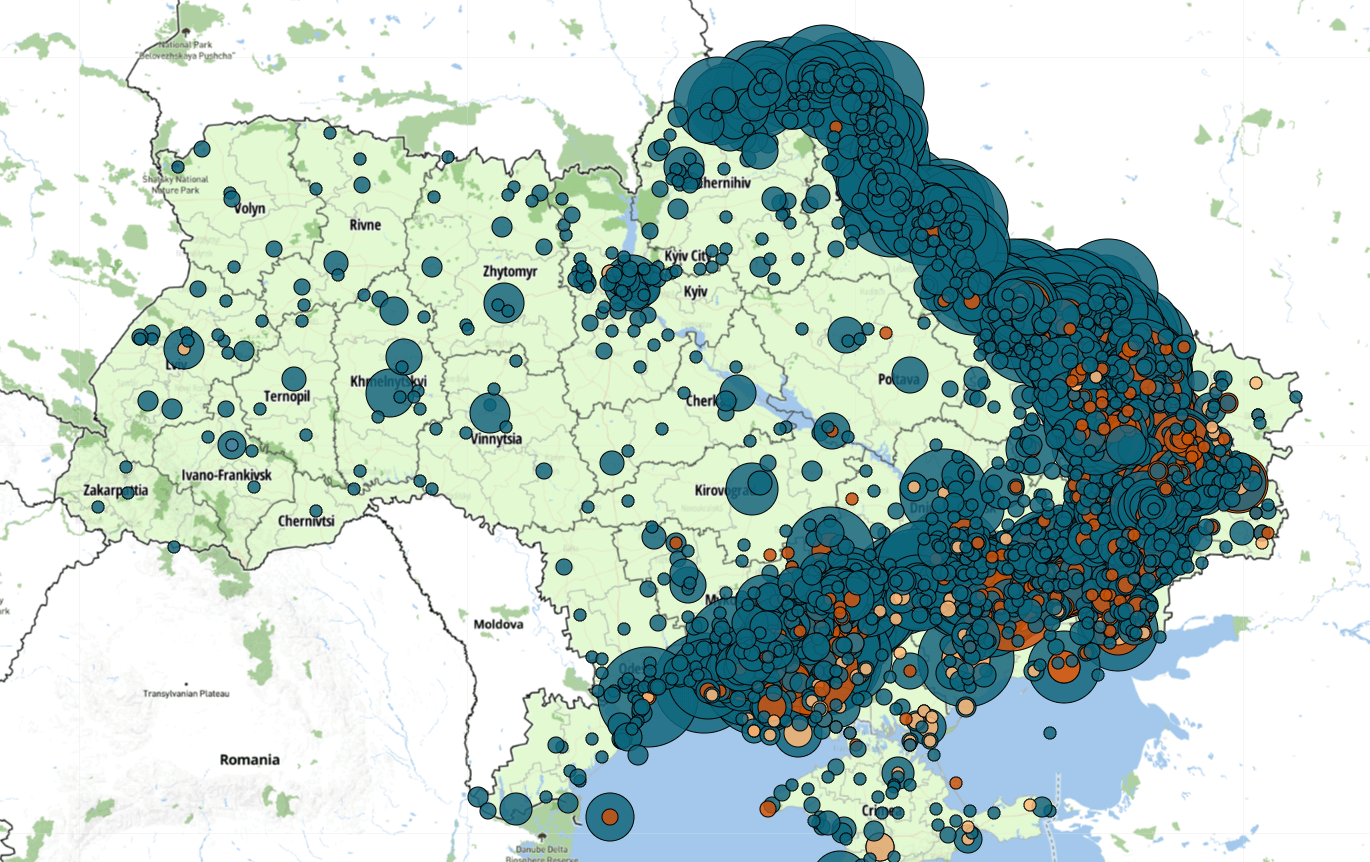
Ukraine & the Black Sea ( 13 June 2025 )
Attacks on Ukranian infrastructure
ACLED uses four automatically generated infrastructure tags when coding events that occur in Ukraine, each covering a vital sector that focuses on civilian infrastructure: energy, health, education, and residential infrastructure. This file contains all events featuring one or more of these tags.
For more information, read our methodology note.
Sign up for Ukraine Conflict Monitor updates
Information & Analysis
For additional information on the conflict in Ukraine, check our analysis of political violence trends from the start of ACLED coverage in 2018.

